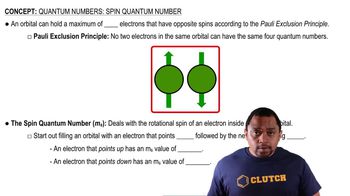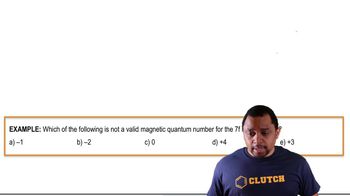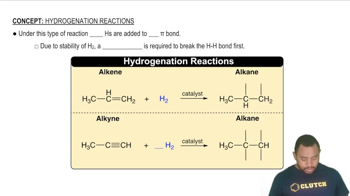Using the periodic table as a guide, write the condensed electron configuration and determine the number of unpaired electrons for the ground state of d. Sb
Ch.6 - Electronic Structure of Atoms
Chapter 6, Problem 102c
In the experiment shown schematically below, a beam of neutral atoms is passed through a magnetic field. Atoms that have unpaired electrons are deflected in different directions in the magnetic field depending on the value of the electron spin quantum number. In the experiment illustrated, we envision that a beam of hydrogen atoms splits into two beams. (c) What do you think would happen if the beam of hydrogen atoms were replaced with a beam of helium atoms? Why?

 Verified step by step guidance
Verified step by step guidance1
Step 1: Understand the experiment setup. A beam of neutral hydrogen atoms is passed through a magnetic field created by a horseshoe magnet, causing the beam to split into two due to the electron spin quantum number.
Step 2: Recall that hydrogen atoms have one electron, which can have a spin quantum number of +1/2 or -1/2, leading to the observed splitting.
Step 3: Consider the electronic configuration of helium atoms. Helium has two electrons, both of which are paired in the 1s orbital.
Step 4: Recognize that paired electrons in helium have opposite spins, resulting in a net spin of zero. This means helium atoms do not have unpaired electrons.
Step 5: Conclude that if the beam of hydrogen atoms is replaced with a beam of helium atoms, the beam would not split in the magnetic field because helium atoms do not have unpaired electrons to interact with the magnetic field.

Verified video answer for a similar problem:
This video solution was recommended by our tutors as helpful for the problem above.
Video duration:
1mWas this helpful?
Key Concepts
Here are the essential concepts you must grasp in order to answer the question correctly.
Electron Spin Quantum Number
The electron spin quantum number describes the intrinsic angular momentum of electrons, which can take on values of +1/2 or -1/2. This property is crucial in determining how electrons behave in magnetic fields, as unpaired electrons will align with or against the field, leading to observable deflections in experiments like the one described.
Recommended video:
Guided course

Spin Quantum Number
Magnetic Deflection of Atoms
When a beam of neutral atoms passes through a magnetic field, atoms with unpaired electrons experience a force due to their magnetic moments. This results in a deflection of the atoms' paths, which can be measured to infer properties about the atoms, such as their electron configurations and the presence of unpaired electrons.
Recommended video:
Guided course

Magnetic Quantum Example
Comparison of Hydrogen and Helium
Hydrogen has one electron, which can be unpaired, while helium has two electrons that are paired, resulting in no net magnetic moment. If a beam of helium atoms were used instead of hydrogen, we would expect minimal or no deflection in the magnetic field, as the paired electrons in helium do not contribute to a magnetic moment that would interact with the field.
Recommended video:
Guided course

Hydrogenation Reactions
Related Practice
Textbook Question
Textbook Question
Scientists have speculated that element 126 might have a moderate stability, allowing it to be synthesized and characterized. Predict what the condensed electron configuration of this element might be.
Textbook Question
In the experiment shown schematically below, a beam of neutral atoms is passed through a magnetic field. Atoms that have unpaired electrons are deflected in different directions in the magnetic field depending on the value of the electron spin quantum number. In the experiment illustrated, we envision that a beam of hydrogen atoms splits into two beams. (a) What is the significance of the observation that the single beam splits into two beams?
